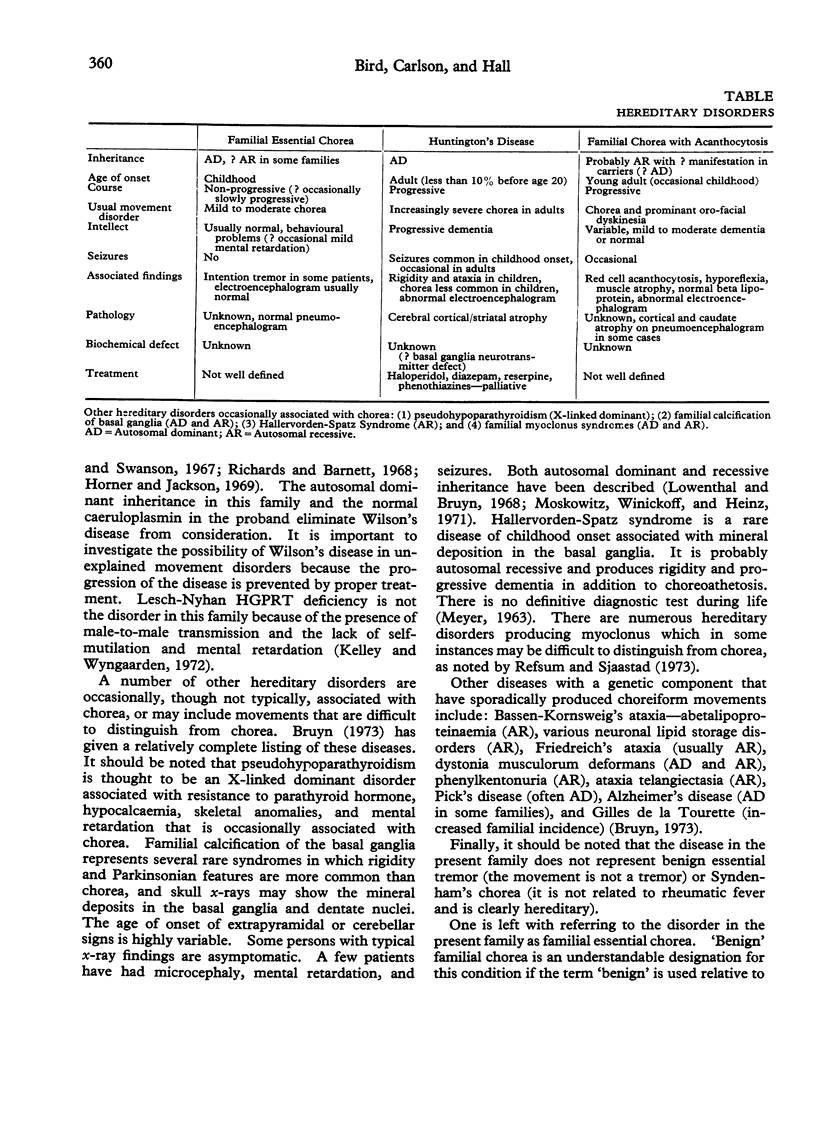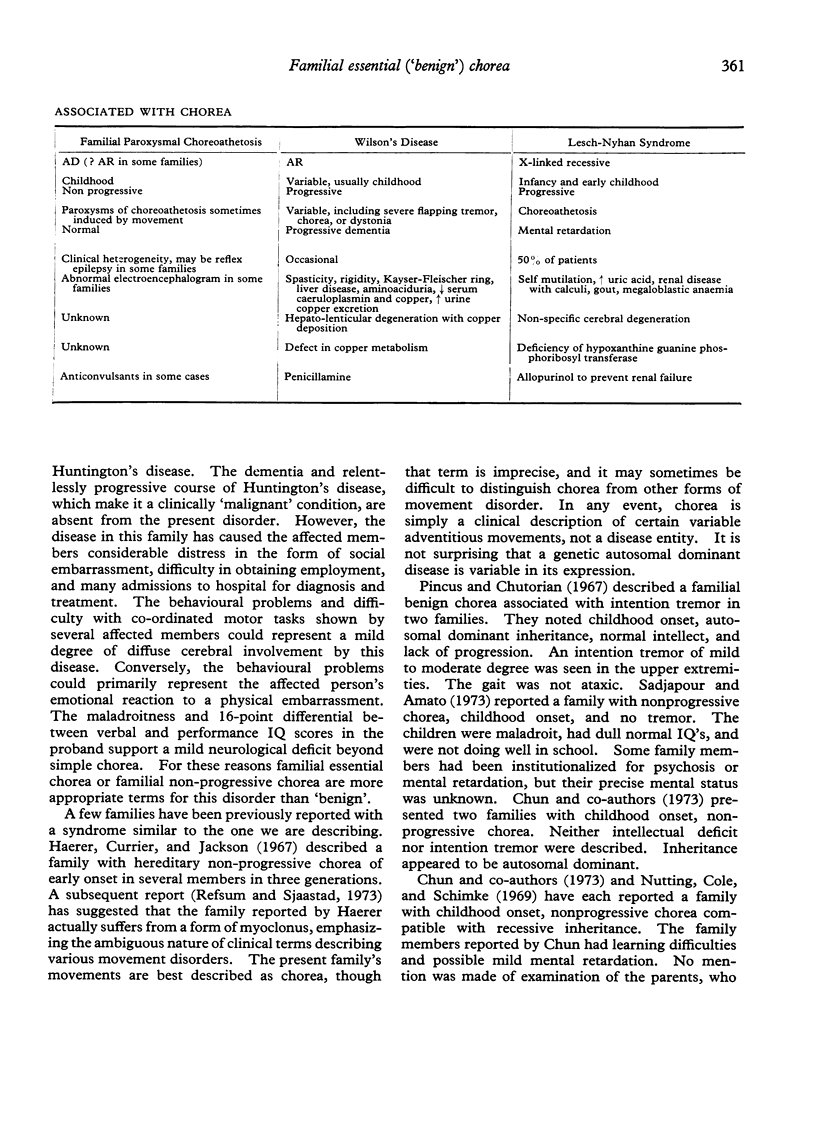Abstract
A family is described with essential non-progressive chorea occurring in an autosomal dominant inheritance pattern over four generations. A few families with an apparently similar disorder have been reported previously. This condition is characterized by early childhood onset of chorea which is not progressive and is compatible with a long life. It is not associated with dementia, seizures, rigidity, or ataxia. It is a socially embarrassing condition and may, sometimes, be associated with behavioural problems and learning difficulties. For genetic counselling, it is important to distinguish this disorder from Huntington's disease and other hereditary disorders associated with chorea.
Full text
PDF





Selected References
These references are in PubMed. This may not be the complete list of references from this article.
- Aminoff M. J. Acanthocytosis and neurological disease. Brain. 1972;95(4):749–760. doi: 10.1093/brain/95.4.749. [DOI] [PubMed] [Google Scholar]
- BLINDERMAN E. E., WEIDNER W., MARKHAM C. H. THE PNEUMOENCEPHALOGRAM IN HUNTINGTON'S CHOREA. Neurology. 1964 Jul;14:601–607. doi: 10.1212/wnl.14.7.601. [DOI] [PubMed] [Google Scholar]
- Byers R. K., Dodge J. A. Huntington's chorea in children. Report of four cases. Neurology. 1967 Jun;17(6):587–596. doi: 10.1212/wnl.17.6.587. [DOI] [PubMed] [Google Scholar]
- Chun R. W., Daly R. F., Mansheim B. J., Jr, Wolcott G. J. Benign familial chorea with onset in childhood. JAMA. 1973 Sep 24;225(13):1603–1607. [PubMed] [Google Scholar]
- Critchley E. M., Clark D. B., Wikler A. Acanthocytosis and neurological disorder without betalipoproteinemia. Arch Neurol. 1968 Feb;18(2):134–140. doi: 10.1001/archneur.1968.00470320036004. [DOI] [PubMed] [Google Scholar]
- Haerer A. F., Currier R. D., Jackson J. F. Hereditary nonprogressive chorea of early onset. N Engl J Med. 1967 Jun 1;276(22):1220–1224. doi: 10.1056/NEJM196706012762202. [DOI] [PubMed] [Google Scholar]
- Kertesz A. Paroxysmal kinesigenic choreoathetosis. An entity within the paroxysmal choreoathetosis syndrome. Description of 10 cases, including 1 autopsied. Neurology. 1967 Jul;17(7):680–690. doi: 10.1212/wnl.17.7.680. [DOI] [PubMed] [Google Scholar]
- Levine I. M., Estes J. W., Looney J. M. Hereditary neurological disease with acanthocytosis. A new syndrome. Arch Neurol. 1968 Oct;19(4):403–409. doi: 10.1001/archneur.1968.00480040069007. [DOI] [PubMed] [Google Scholar]
- Moskowitz M. A., Winickoff R. N., Heinz E. R. Familial calcification of the basal ganglions: a metabolic and genetic study. N Engl J Med. 1971 Jul 8;285(2):72–77. doi: 10.1056/NEJM197107082850202. [DOI] [PubMed] [Google Scholar]
- Nutting P. A., Cole B. R., Schimke R. N. Benign, recessively inherited choreo-athetosis of early onset. J Med Genet. 1969 Dec;6(4):408–410. doi: 10.1136/jmg.6.4.408. [DOI] [PMC free article] [PubMed] [Google Scholar]
- Perez-Borja C., Tassinari A. C., Swanson A. G. Paroxysmal choreoathetosis and seizures induced by movement (reflex epilepsy). Epilepsia. 1967 Dec;8(4):260–270. doi: 10.1111/j.1528-1157.1967.tb04442.x. [DOI] [PubMed] [Google Scholar]
- Pincus J. H., Chutorian A. Familial benign chorea with intention tremor: a clinical entity. J Pediatr. 1967 May;70(5):724–729. doi: 10.1016/s0022-3476(67)80322-6. [DOI] [PubMed] [Google Scholar]
- Richards R. N., Barnett H. J. Paroxysmal dystonic choreoathetosis. A family study and review of the literature. Neurology. 1968 May;18(5):461–469. doi: 10.1212/wnl.18.5.461. [DOI] [PubMed] [Google Scholar]


